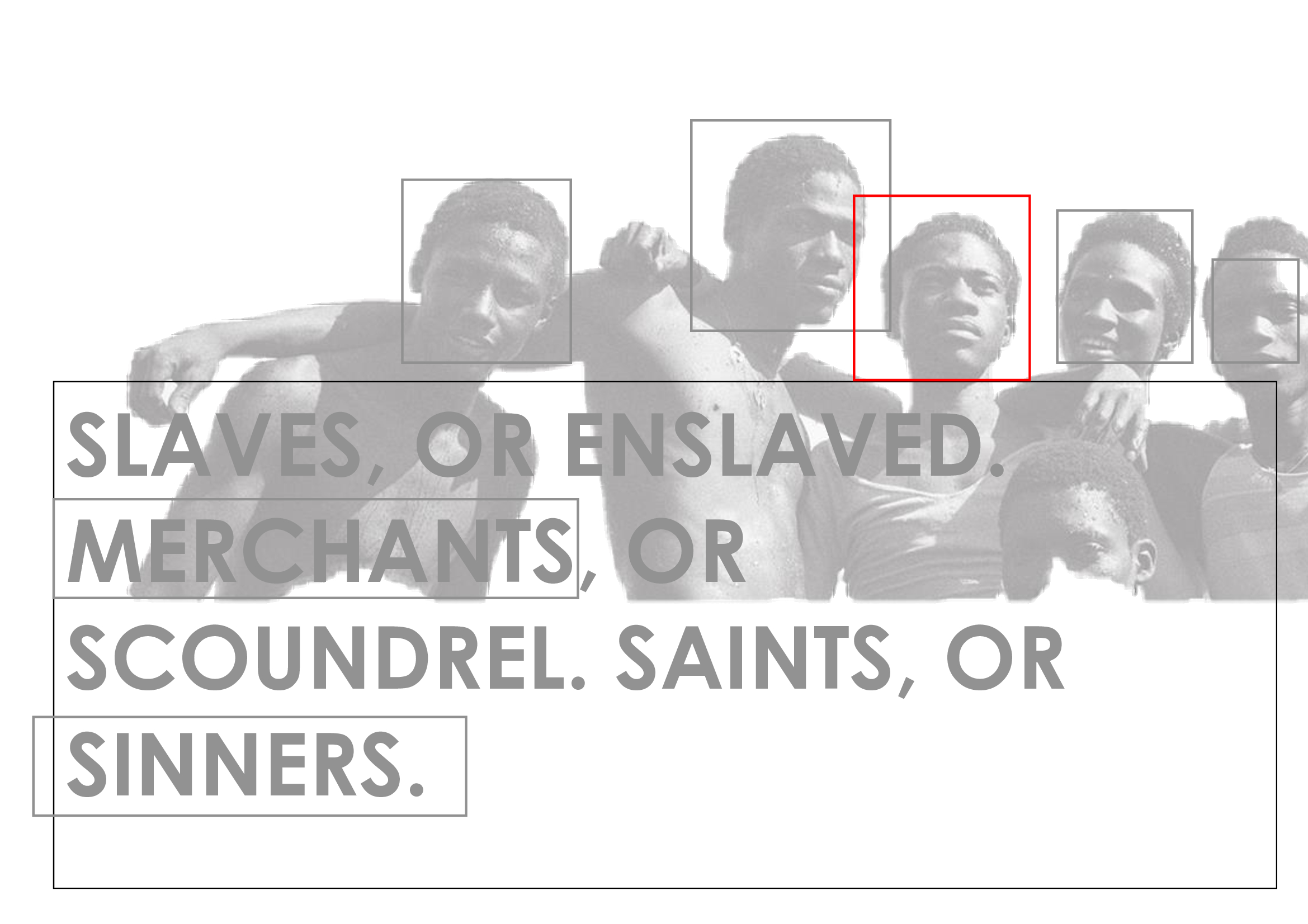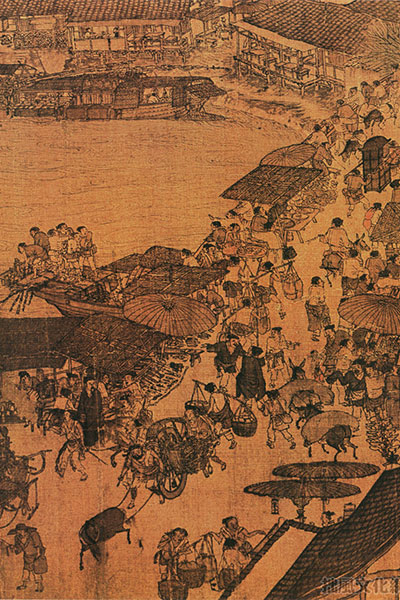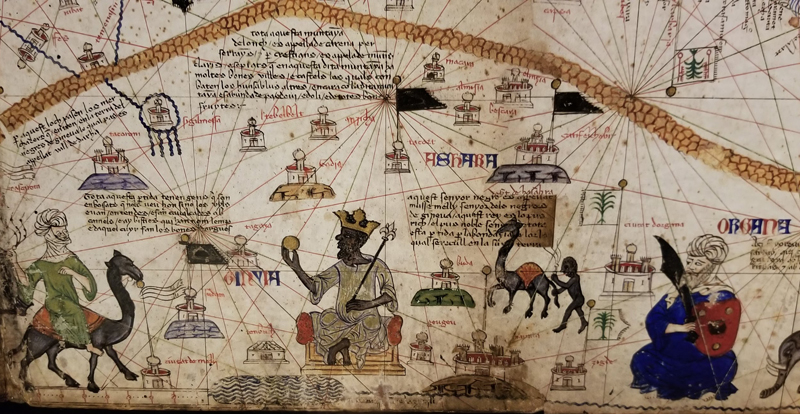-

Ifihan ati Ago
Áfíríkà àtijọ́ kò yà sọ́tọ̀ kúrò nínú ayé àtijọ́.
Itan ati onimo iwadi pese a duro oye ti atijọ trans-asahara isowo, lati isunmọ 4000 BC (gun ṣaaju si awọn 1st orundun CE; ati apejuwe bi bẹrẹ pẹlu awọn ọjọ ori ti African metallurgy ninu ọran ti Senegal), leta ti atijọ Ijọba ti Kuṣi ninu Kerma, Sudan; nipasẹ awọn Darb el-Arbain ipa-ọna iṣowo, ati iṣowo yika ninu turari, alikama, awọn turari, goolu, iyọ, ẹranko/adie, alamọdaju ati ehin-erin; ati pataki, agbewọle ti awọn ohun alumọni bii 'obsidian'lati Senegal lati ṣẹda awọn abẹfẹlẹ, awọn nkan, ati iṣẹ irin. Iwadi nipa ẹda eniyan aipẹ ti wa bayi Manding inscriptions ninu awọn ipon igbo ti ila gusu Amerika.
The Silk Routes
The interlocking trade networks connecting Africa to most of the Old World, brought about an exchange of trade in oriental [eastern] silks for awọ yẹlo to ṣokunkun, jade, àwọ̀, turari, wura, epo ati Awọn ohun elo ti a ṣe, ati be be lo, sunmọ 114 Bc, lati awọn jù Oba Han.
Awọn aworan ti siliki gbóògì wà ohun iyasoto Kannada okeere ni asiko yii, ati awọn iwe aṣẹ ijọba Han ṣe afihan awọn ibatan diplomatic ati iṣowo laarin ijọba Han ati Afirika, pẹlu aṣoju ijọba ijọba kan.Zhang Qian' ti a firanṣẹ si iṣowo transcontinental ti o ni aabo, bakannaa ṣẹda awọn aabo aabo iṣelu, fun iṣowo siliki ti n dagba. Iwa yii tẹsiwaju si ibẹrẹ Oba Mingpẹlu awọn igbasilẹ ti 'Zheng He‘ (a diplomat and Admiral) visiting the interior of Africa between Ọdun 1419 CE ati Ọdun 1433 CE, and African ambassadors invited to visit Emperor Zhu Di sunmọ Ọdun 1421 CE.
Awọn Graeco-Roman periplus "Periplus ti Okun Erythraean” tun pese igbasilẹ ti awọn itineraries ti ọkọ oju omi ati awọn aye iṣowo laarin Afirika ati awọn ebute iṣowo ita / ilana ilana.
Awọn Ijọba Romu jogun awọn nẹtiwọki iṣowo ti iṣeto ti o ṣẹda apakan ti Silk Road laarin awọn ọna iṣowo ila-oorun ati Afirika, awọn wọnyi iṣẹgun ti Egipti ninu 30 Bc.
What is now known as ‘the silk routes, or silk road’ existed for more than 1,500 years, until approximately Ọdun 1453 CE.

Awọn Zimbabwe nla, Ara Malia ati Ottoman Ghana dubulẹ lori ọna iṣowo, laarin etikun ila-oorun ati inu ilohunsoke ti Afirika, fifun ọpọlọpọ awọn alarinkiri ati awọn iṣowo iṣowo, ati ibeere fun owo-ori ati aabo ni ọna.
Ẹsin, awọn imọ-ẹrọ tuntun, ĭdàsĭlẹ ati awọn imọran tan kaakiri awọn ọna iṣowo Afirika gẹgẹ bi omi ti n ṣafẹri bi awọn ẹru, ti o yorisi idagbasoke ti awọn ilu aṣa ni inu inu ti awọn ọna iṣowo trans-saharan, eyun Gao ati Timbuktu, ati be be lo
Ni tente oke ti awọn African Renesansi, eto ijọba ti o ṣeto daradara labẹ iṣakoso ti Ọba, bii Musa Keita I tabi Mansa Musa, irin-ajo lọpọlọpọ ati awọn nẹtiwọọki iṣowo ti awọn oniṣowo Afirika ati awọn ọjọgbọn Islam ti Afirika ṣe idagbasoke iṣowo iwe pataki kan, ati iṣeto Timbuktu gẹgẹ bi ile-ẹkọ ile-ẹkọ giga ni Afirika, bii Ọdun 988 CE ati siwaju.
Bi abajade, awọn itan ti ọrọ Afirika, awọn okeere okeere, isọdọtun, igbesi aye ati aṣa ti o ga julọ jẹ ki akiyesi ni Yuroopu, nitori kii ṣe ọlọrọ pupọ, ṣugbọn tun jẹ ohun aramada paapaa. Awọn itan wọnyi ṣe iranlọwọ fun iwulo Ilu Yuroopu ati iṣawakiri awọn aye ni Afirika.
Idinku ti awọn ijọba wọnyi (awọn ilu-ilu Afirika) jẹ abajade lati iyipada ninu awọn agbara ti iṣowo kariaye, awọn idije inu [paapaa, awọn Saadian/Ilu Morocco ayabo ti awọn Niger inu ilohunsoke, Ogun ti Tondibi, ati Ogun ti Alcácer Quibir] titun gbokun isowo ipa-, to ti ni ilọsiwaju Maritaimu / lilọ ogbon ati ohun ija, pọ eletan ati idije fun ilẹ, wiwọle si de ati oro bi goolu, a naficula ni lagbaye gaba ati alagbaro.
Pipin iṣelu ti agbegbe naa, jija ti awọn ilu aṣa-ọpọlọpọ, awọn iwe-iwe ati awọn iṣura ti awọn ijọba ti aarin gẹgẹbi Mali, Songhai, Kongo/Congo, ati wiwa ti n pọ si ti Ottoman's ati Portugal ti samisi opin agbegbe naa bi ipa ti o munadoko / agbara ni iṣowo.

Background: The beginnings of European activity in Africa.
Like other foreign travelers and purveyors of goods prior, African merchants and traders were certainly open to the European newcomers.
Awọn dide ti akọkọ European onisowo, lori 5440 ọdun lẹhin ti awọn paṣipaarọ ti (mọ ati ki o ni akọsilẹ) iṣowo bẹrẹ ni Afirika, o le sopọ mọ ọdọ olorin Portuguese kan 'Antam Gonçalvez' ẹniti, lẹhin ti o gbọ awọn itan ti agbara fun iṣowo ati ere, bẹrẹ irin ajo lọ si Iha Iwọ-oorun Iwọ-oorun Iwọ-oorun Afirika ni Ọdun 1441 CElabẹ itọnisọna ti 'Dom Henrique of Portugal, Duke of Viseu'lati gba awọn awọ ara, ata dudu, turari ati epo, fun tita siwaju ninu Lisbon.
Portugal nfẹ lati ṣe idaduro anikanjọpọn lori iṣowo ni Afirika, o wa idalare ti ipo rẹ, awọn iwadii kutukutu ati aaye ti ipa (titun-ri iṣowo ipa-), nipasẹ a Papal Bull ti Ọdun 1442 CE, ti a yàn nipa Pope Eugene IV, the consequence of which would be the legitimisation of enslavement of captives within Africa, under the premise and designation of the enterprise as a crusade; a Papal Bull nipasẹ Pope Nicolas V, ni 1452 CE ati 1455 SK, ati Papal akọ màlúù kan di mímọ awọn Adehun ti Tordesillas (ni ọdun 1494 SK).
Ni akoko, nigba awọn 15th ati 17th sehin, fadaka ati wura wà ni agbaye awọn ajohunše ti paṣipaarọ ni Europe ati Asia. Ipese awọn irin iyebiye jẹ pataki lati ṣe igbelaruge awọn ọrọ-aje, ati lati ṣe afẹyinti awọn owo nina fun paṣipaarọ ati gbigbe wọle.
Kanna kannaa ati ohun elo ologun wà operational ni nilokulo ti Mayan wura nipa Spain, ati nigbati yi je ti re, awọn exploits ti fadaka maini ti Mexico. Indeed, much of the rivalry between European countries in the 15th and 18th centuries were born out of the desire to protect and prop up their currencies.
Awọn iroyin ti awọn ilokulo Portuguese ni Afirika ni a gbọ ni adugbo Spain, ati ki o kọja awọn iyokù ti Yuroopu, pẹlu julọ inú sosi jade ti awọn ikogun.
Laarin Ọdun 1495 CE ati Ọdun 1559 CE, ọgọ́rọ̀ọ̀rún àwọn ọkọ̀ ojú omi Potogí ni àwọn ọmọ ilẹ̀ Gẹ̀ẹ́sì kó, tí wọ́n kó wọn, tí wọ́n sì kó wọn lọ, bákan náà, àwọn ará Gẹ̀ẹ́sì ń kópa nínú iṣẹ́ agbófinró. Ogun ti Agadir ('Santa Cruz') Ọdun 1541 CE.
Ọba John III ti Portugal kowe si Queen Mary of England (Ọdun 1555. CE) as a consequence, demanding reparations for the seized and looted ships. Notably, in both Portugal and Spain, it was the monarch who instituted titles to trade monopolies across the new ‘emerging commercial frontier’, deriving a duty, or tax for trade monopolies.
Ago akiyesi ti ilowosi European ni Afirika pẹlu Spain (lati 1462); Great Britain (lati 1562, with Bermuda di ohun-ini ade ni ọjọ 23 Oṣu kọkanla 1614), Ariwa America (lati 1619); Holland (lati 1592); France (lati 1594), e.t.c.
Trade with Africa required enormous wealth, and financing. It remained the exclusive privilege of emperors, noblemen, or rich merchants. The Europeans thus developed further innovations, for commerce in Africa, through the establishment of trading corporations. The Dutch East India Company, Danish West India Company and The French West India Company were formed in 1602/1659/1664 respectively, which enabled a broader spectrum of merchants to invest in the profitable newly found trade in Africa; insuring, and spreading its business risks.
Awọn Ile-iṣẹ ti Royal Adventurers ti England ti a da ni 1660 nipa Ọba Charles II ti England, iwe-aṣẹ ti o funni ni anikanjọpọn ti iṣowo ni etikun iwọ-oorun ti Afirika, ti n yipada sinu Ile-iṣẹ Royal African ninu 1672.
The evolution of this innovative institution, the joint stock/trading company, was the single most significant development in the world of 17th century commerce. This guaranteed Western Europe could harness its resources towards the structuring and maintaining of trade in Africa, as well as much of the world.
Nikẹhin, o ṣe agbekalẹ ẹrọ nipasẹ eyiti Yuroopu, lairotẹlẹ, tan kaakiri, wọ inu ati ṣe ijọba pupọ julọ agbaye.
During this period the social and political landscape of Europe experienced successive transformations from the feudal, to the mercantile and to an industrial business hub. London, Antwerp, Liverpool, Amsterdam and Nantes emerged as prime financial centers of Europe. What is rarely told is that a staggering 40% of the UK’s budget in Ọdun 1833 CE, the equivalent of approximately £20bn in today’s terms, was used to compensate the English merchants towards the eventual demise and collapse of the illicit profiteering of trade in Africa; excluding displaced African’s from any recompense.
Idinku ati aṣa ti idinku aṣa Afirika ati aaye rẹ ninu itan-akọọlẹ: Ede ti Legal Fiction.
Awọn Corpus Juris ṣẹda ipilẹ to ṣe pataki lati eyiti lati ronu nipa iṣoro ti ofin eniyan.
Ius naturale / (lex naturalis), (ayeraye ati aileyipada) n funni ni imọran, awọn iye ti ara ẹni, ojulowo si ẹda eniyan - awọn ẹda ti o ni agbara ti o ni agbara ti kii ṣe nipasẹ ẹni-kọọkan nikan, awọn iwulo ati awọn ifẹkufẹ, ṣugbọn imọ-ara (aiji), awọn ẹtọ, awọn anfani, awọn adehun, agbara lati ṣẹda awọn ibatan ofin , ati nipa awọn ifilelẹ ti irora, aisan, ijiya ati iku.
Awọn imọran iwuwasi ilana ilana ti jurisprudence (awọn ofin ofin) ṣẹda awọn oju-ọna ti idanimọ fun ọpọlọpọ / awọn nkan lọpọlọpọ, awọn ẹgbẹ, awọn ẹni-kọọkan, ilana ti “miiran”, ṣiṣe eniyan, ati faagun agbegbe awọn eniyan. Eyi jẹ iṣoro, iyọnu nipasẹ aidaniloju ati aidaniloju (ni buruju, lainidii), ati ṣe opin agbara kikun ati ileri ti eniyan.
Terms such as “slave” or “enslavement” pervades and conditions all other inherent identities, either chosen or given. To reduce the eniyan to a nonhuman noun is to produce linguistic violence, and strips the individual of agency. To argue contrary flies in the face of empirical fact. The scholarly exercise of embellishing and sugar-coating the language of historical recall, implies a degree of wilful and/or premeditated amnesia and wastes an opportunity to reinforce the brutish-callousness of the word.
Bakanna, idinku awọn otitọ ile Afirika gẹgẹbi, awọn aṣoju arosọ, tabi awọn iṣẹlẹ, laisi imọ-ọrọ ati imọ-ọrọ - pe awọn ọmọ Afirika ko ni itan - jẹ ero Eurocentric, ti a fun ni akoko ti a ti sọ tẹlẹ; ati ki o ko fidimule ni mon. Beena ni imusin imusin ti 'aye-kẹta', 'aini idagbasoke', 'idagbasoke', tabi 'aiṣedeede' - ṣe idajọ ni ibamu si awọn iṣedede Eurocentric.
Social critic and sociologist WEB Du Bois defined this peculiar/eurocentric faux-ethnographic characterisation of the African sociocultural ethnology, as indeed a new invention – a religion founded on the eurocentric (scholarly) dogma that all the hues of God are grounded on the intrinsic hierarchy of religious orthodoxy; with the inevitable corollary of the collective physical, ideological, religious, systemic or cultural traits of the ‘Omiiran' (awọn ẹni-kọọkan ti o wa ni ita ọna agbara hegemonic ti ode oni) bi significantly kere prized nipa 'igbalode awujo'.
The primary basis of this reconfiguration, was to institute and strengthen the agency of eurocentric capitalist systems, backed by a cluster of social, incorporeal/religious, semantic conjecture and legal regimes.
As a result, and beyond any doubt, where this new religion (or hegemonic construct) was not able to win converts through peaceful inducement or fear, it deployed cruder methods to safeguard its power, conscripting laws, customs and institutions to put into effect its prerogatives.
Ipari:
A sosioloji ti gaba emerged nipasẹ awọn Papal Bulls ti Ọdun 1442 CE, Ọdun 1452 CE, Ọdun 1455 CE, ati Ọdun 1494 CE. Awọn imọ-jinlẹ ti o ni nkan ṣe ati awọn ami afọwọsi-ijinle sayensi ti awọn iyatọ adayeba ti 18th, 19th, ati awọn 20 orundun, igbekalẹ ati pese idalare iwa lati fowosowopo avarice eto ti o njade lati Yuroopu ati Amẹrika; yori soke si awọn 21st orundun. Awọn mojuto ti yi eto ti wa ni deede nipasẹ imusin fọọmu ati awọn alabọde; ti a fi sii lọpọlọpọ ninu awujọ, imọ-jinlẹ, eto-ọrọ / eto-ọrọ, iṣelu (eto imulo gbogbogbo), ẹkọ, ẹmi, media, awọn aaye iwe-kikọ ati aṣa, ati adaṣe nipasẹ oju opo wẹẹbu intricate ti awọn ilana ati awọn ofin, igbekalẹ ati agbara igbekalẹ ti kojọpọ laipẹ.
The European intervention broke down African advanced, progressive, political and social structures. Until the mid-fifteenth century (CE), Afirika je ohun nyoju aje powerhouse. Àárín Gbùngbùn Áfíríkà ní àṣà ìbílẹ̀ irin tí ó gbóná ti tó wà ní ìsopọ̀ pẹ̀lú Àríwá, Gúúsù àti Òkun Íńdíà. Iwọ-oorun Afirika ni asopọ si Mẹditarenia nipasẹ awọn ọna iṣowo kọja Sahara. The European dide ti Ọdun 1441 CE siwaju, Idilọwọ awọn adayeba itankalẹ ti awọn burgeoning African intricate àsà ti owo ayika; awọn oniwe-ise, specialized / ijinle sayensi, atijọ ti esin ati omowe ala-ilẹ.
Idarudapọ ti o tẹle ni o fa iyapa ti awọn idile, ti ko ni ibanujẹ ailopin lori ọkunrin, obinrin ati awọn ọmọde, pẹlu Afirika ti o padanu awọn alamọja ọgbọn ọdun ọgọrun ọdun, awọn alagbẹdẹ goolu, awọn ohun ọṣọ iyebiye, awọn ọgbẹ, awọn gbẹnagbẹna, awọn agbe, awọn akọrin, awọn alufaa, awọn kootu, awọn alaṣẹ ọba ati awọn ọjọgbọn; isonu ti awọn aladugbo, arakunrin, arabinrin, arabinrin, anti, aburo, ọmọkunrin, ọmọbinrin, ibatan, iya, baba, asa,….
Fun arosọ kan ti o da lori ilana ti iṣelọpọ pseudo-hegemonic cum-capitalist, ipa apanirun lori kọnputa Afirika, ni idile idile, ọrọ-aje ati awọn ofin inawo, ko ni iwọn.
© ÀGBÁRA

